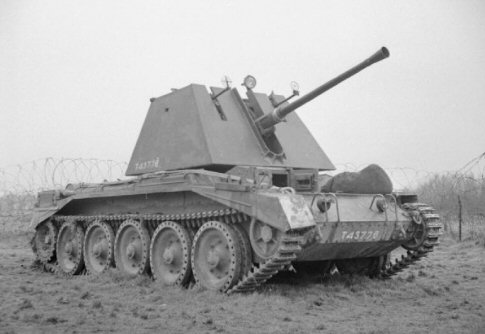|
|
|
|
|
|
 |
 |
|
|
|
|
|
|
|
|
|
|
|
Britain
Cruiser Mk VI (Crusader III AA MkI)
Ordnance classification - A15
|
| The Cruiser Mk VI was a Self Propelled Anti Aircraft vehicle designed in 1942, manufactured by Nuffield, it was based on the fully tracked A13 III(Covenanter) chassis and was in use from 1942 to 1945. It was commonly called a Crusader III AA MkI. |
|
|
|

Menzies (Cpl) War Office official photographer, Public domain, via Wikimedia Commons
|
| General Details (SP Anti Aircraft) |
|---|
| | Specifications | | Operational Date(s) | 1942 - 1945 | | Ordnance classification | A15 | | Quantity Produced | 5300 | | Weight | 20 tonne | | Crew | 3 | | M.G's small | n/a | | M.G's large(>10mm) | n/a | | Length | 6.05 mtr | | Width | 2.66 mtr | | Height | 2.62 mtr | | Engine Details/Performance | | Max Road Speed | 28 mph | | Max Cross Country Speed | 15 mph | | Range Road | 112 miles | | Range Cross Country | 44 miles | | Fuel Type | Petrol | | Fuel Capacity | 120 gal | | Horse Power | 340 hp | | Power/Weight | 17 hp/tonne | | | General Information | The Cruiser Mk VI was a Self Propelled Anti Aircraft vehicle designed in 1942, manufactured by Nuffield, it was based on the fully tracked A13 III(Covenanter) chassis and was in use from 1942 to 1945. It was commonly called a Crusader III AA MkI.
The vehicle was powered by Nuffield 'Liberty' petrol powerplant producing 340 HP which could drive the vehicle on roads at up to 28 mph with a range of about 112 miles before refuelling. Its cross country performance was good providing a max speed of about 15 mph and a range of about 44 miles.
Its main armament consisted of an Bofors 40 mm L/60 which could penetrate 46 mm of flat plate at 800 metres
The Crusader tank was a redesigned A13 Mk III as a heavy cruiser tank that could rapidly move and provide good A/T performance.
The Mk I AA turret was a plain shape that held the 40mm Bofors AA gun. The auxiliary machine gun turret was removed in the MkIII Crusader. | |
| | Turret | | Front | | 49mm | @ | 7° | (49mm) | | Side | | 24mm | @ | 45° | (34mm) | | Rear | | 30mm | @ | 32° | (35mm) | | Top | | 12mm | @ | 90° | (12mm) |
| | Superstructure | | Front | | 20mm | @ | 60° | (40mm) | | Side | | 14mm | @ | 0° | (14mm) | | Rear | | 14mm | @ | 11° | (14mm) | | Top | | 7mm | @ | 90° | (7mm) |
|
| Hull | | Front | | 20mm | @ | 45° | (28mm) | | Side | | 14mm | @ | 0° | (14mm) | | Rear | | 14mm | @ | 11° | (14mm) | | Top | | 7mm | @ | 90° | (7mm) |
| | Armour (x)mm @ (y)° (Effective mm @ 0°) | | Effective Armour - Maximum 49 mm - Minimum 7 mm |
| | | Weapon Details |
|---|
|
|
Bofors 40 mm L/60
(Anti Aircraft) |
 |
|
| Ammunition Details |
|---|
| Name/Id |
Calibre Weight MVelocity |
Explosive Content |
|
40 × 311 mm R
(HE High Explosive)
|
40mm 0.95Kg 850M/Sec | ≈0.143Kg explosive |
| Range(Mtr) | 1000 | 2000 | 3000 | 4000 | 5000 | 6000 | 7000 | 8000 |
|---|
| Flight Time(Secs) |
1.57 |
4.71 |
14.18 |
|
|
|
|
|
|---|
| Direct Fire |
| Range(Mtr) | 100 | 200 | 400 | 800 | 1200 | 1600 | 2000 | 2400 |
|---|
| Flight Time(Secs) |
0.12 |
0.25 |
0.52 |
1.18 |
2.02 |
3.14 |
4.71 |
7.06 |
|---|
| Hit Probability(%) |
98 |
98 |
98 |
96 |
64 |
25 |
8 |
2 |
|---|
| Blast/Fragmentation Effects |
| Burst radius Infantry in open 99% kill | 2 mtr |
Burst radius Infantry in open 66% kill | 5 mtr |
|---|
| Burst radius Infantry in open 33% kill | 13 mtr |
Armour Penetration inc roof at 1 mtr | 0 mm |
|---|
| An explosion within 2 mtr of infantry in the open will cause 99% casualties - lethal. |
| An explosion within 5 mtr of infantry in the open will cause > 66% casualties and could damage some AFV's. |
| An explosion within 13 mtr of infantry in the open will cause 33% casualties. |
| The blast effect of this shell exploding within 1 mtr of an armoured vehicle will not cause any significant armour damage. |
|
|
|
Hit probability is based on a static 2 x 2.4 metre panel at 0 degrees(vertical) at the range specified.
The data that has been used to create these records has come from Wikipedia, The Lone Sentry, The Bundes Archive
and numerous books and websites that have provided the detailed information that has not been available anywhere else. The
information we use to calculate the penetration tables, flight times and the hit probability comes from the Gun Calibre,
the Shell Mass(Kg) and the muzzle velocity, plus range reductions to allow for gravity and wind resistance. This calculation
originally came from a pre-war Krupp calculation which has been modified, and seems to fit the actual test results.
© WWIITanks 1980-2025
|
|
|
|
|
|
